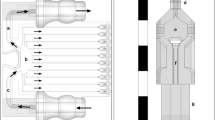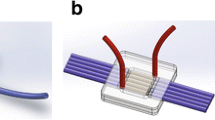Abstract
Cell-laden microfluidic devices have broad potential in various biomedical applications, including tissue engineering and drug discovery. However, multiple difficulties encountered while culturing cells within devices affecting cell viability, proliferation, and behavior has complicated their use. While active perfusion systems have been used to overcome the diffusive limitations associated with nutrient delivery into microchannels to support longer culture times, these systems can result in non-uniform oxygen and nutrient delivery and subject cells to shear stresses, which can affect cell behavior. Additionally, histological analysis of cell cultures within devices is generally laborious and yields inconsistent results due to difficulties in delivering labeling agents in microchannels. Herein, we describe a simple, cost-effective approach to preserve cell viability and simplify labeling within microfluidic networks without the need for active perfusion. Instead of bonding a microfluidic network to glass, PDMS, or other solid substrate, the network is bonded to a semi-permeable nanoporous membrane. The membrane-sealed devices allow free exchange of proteins, nutrients, buffers, and labeling reagents between the microfluidic channels and culture media in static culture plates under sterile conditions. The use of the semi-permeable membrane dramatically simplifies microniche cell culturing while avoiding many of the complications which arise from perfusion systems.







Similar content being viewed by others
References
K. Aran, L.A. Sasso, N. Kamdar, J.D. Zahn, Lab Chip 10(5), 548–552 (2010)
J. El-Ali, P.K. Sorger, K.F. Jensen, Nature 442(7101), 403–411 (2006)
A. Khademhosseini, R. Langer, J. Borenstein, J.P. Vacanti, Proc Natl Acad Sci U S A 103(8), 2480–2487 (2006)
L. Kim, M.D. Vahey, H.Y. Lee, J. Voldman, Lab Chip 6(3), 394–406 (2006)
N. Korin, A. Bransky, U. Dinnar, S. Levenberg, Biomed Microdevices 11(1), 87–94 (2009a)
N. Korin, A. Bransky, M. Khoury, U. Dinnar, S. Levenberg, Biotechnol Bioeng 102(4), 1222–1230 (2009b)
P. Lee, R. Lin, J. Moon, L.P. Lee, Biomed Microdevices 8(1), 35–41 (2006)
Y. Ling, J. Rubin, Y. Deng, C. Huang, U. Demirci, J.M. Karp et al., Lab Chip 7(6), 756–762 (2007)
Y. Luo, M.S. Shoichet, Nat Mater 3(4), 249–253 (2004)
G. Mehta, K. Mehta, D. Sud, J.W. Song, T. Bersano-Begey, N. Futai et al., Biomed Microdevices 9(2), 123–134 (2007)
J. Park, F. Berthiaume, M. Toner, M.L. Yarmush, A.W. Tilles, Biotechnol Bioeng 90(5), 632–644 (2005)
D.I. Shreiber, P.A. Enever, R.T. Tranquillo, Exp Cell Res 266(1), 155–166 (2001)
H.G. Sundararaghavan, S.N. Masand, D.I. Shreiber, J Neurotrauma, 2011. doi:10.1089/neu.2010.1606.
S. Takayama, J.C. McDonald, E. Ostuni, M.N. Liang, P.J. Kenis, R.F. Ismagilov et al., Proc Natl Acad Sci U S A 96(10), 5545–5548 (1999)
A. Tourovskaia, X. Figueroa-Masot, A. Folch, Lab Chip 5(1), 14–19 (2005)
G.M. Walker, H.C. Zeringue, D.J. Beebe, Lab Chip 4(2), 91–97 (2004)
G.M. Walker, J. Sai, A. Richmond, M. Stremler, C.Y. Chung, J.P. Wikswo, Lab Chip 5(6), 611–618 (2005)
G.M. Whitesides, E. Ostuni, S. Takayama, X. Jiang, D.E. Ingber, Annu Rev Biomed Eng 3, 335–373 (2001)
Acknowledgments
Funding for these studies was provided by the National Science Foundation (NSF-ARRA-CBET 0846328) and National Institutes of Health (NIH 1R21EB009245-01A1). SNM was supported by the Rutgers-UMDNJ Biotechnology Training Program (NIH Grant Number 5T32GM008339-20) and an NSF-IGERT on the Integrated Science and Engineering of Stem Cells (NSF DGE 0801620).
Author information
Authors and Affiliations
Corresponding author
Rights and permissions
About this article
Cite this article
Masand, S.N., Mignone, L., Zahn, J.D. et al. Nanoporous membrane-sealed microfluidic devices for improved cell viability. Biomed Microdevices 13, 955–961 (2011). https://doi.org/10.1007/s10544-011-9565-z
Published:
Issue Date:
DOI: https://doi.org/10.1007/s10544-011-9565-z




